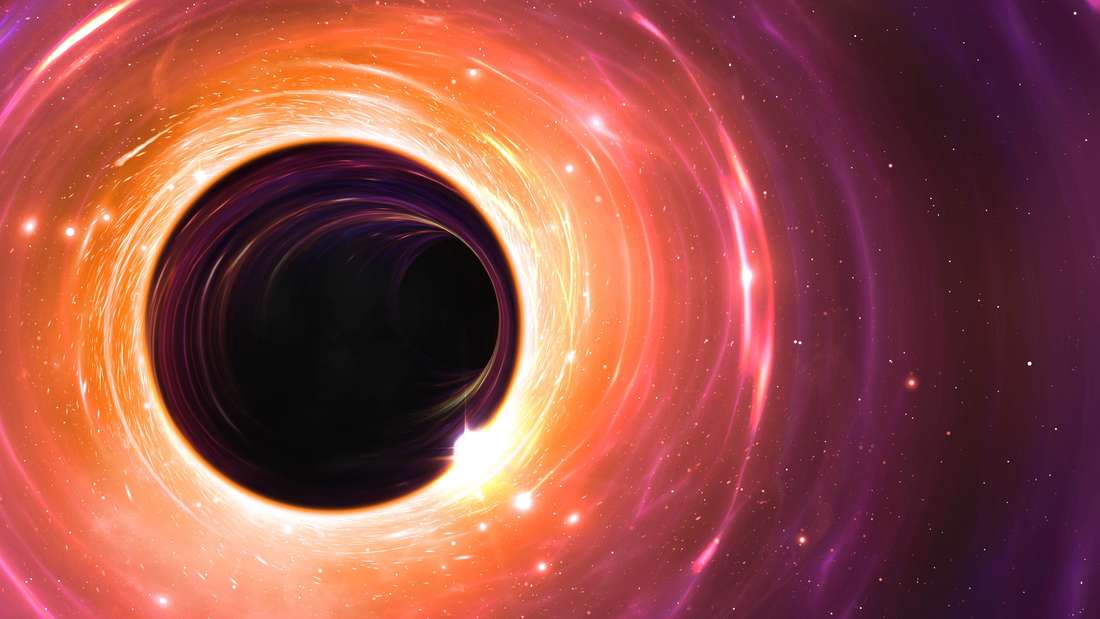
Researchers discover a star dangerously close to the black hole in the center of the Milky Way. The researchers face a conundrum.
Cologne – Researchers recently published the first image of the supermassive black hole at the center of our Milky Way galaxy. A sensation, because black holes are actually invisible: they swallow everything that gets too close to them, and nothing escapes them – not even light. But there are still ways to study black holes: by focusing on their immediate surroundings. In the case of the Sagittarius A* black hole, which is located in the center of the Milky Way, researchers have been observing a densely packed star cluster very close to it for many years. Now researchers have discovered a star in which it should record several records at the same time.
There are more than a hundred stars in the star cluster, their brightness and masses vary. S-stars move especially fast. Observing them also allows to see the effects of the black hole’s gravity. Using this method, two research teams succeeded in discovering the black hole at the center of the Milky Way in the 1990s. German researcher Reinhard Genzel and American researcher Andrea Geis were awarded the Nobel Prize in Physics in 2020.
The star orbits a black hole in the center of the Milky Way at record speed
But stars around a black hole are still important: A few years ago, Genzel and his team followed suit and confirmed Albert Einstein’s theory using stars around a black hole. At the time, researchers set their sights on the star S2, which orbits the black hole about once every 15 years. But for current research work, S2 appears to have been somewhat annoying: “S2 acts like a big guy sitting in front of you in the cinema: it obstructs your vision of the basics,” reports Florian Bisker, lead author of a new study that Published in the Astrophysical Journal had become.
| Noun | S4716 |
| Type | S-Stern |
| Ort | Cluster S, near the center of the Milky Way |
| The orbital period around the black hole | 4 years |
| The distance from the black hole | 99 to 706 AU |
| Speed | 1200 to 8000 kilometers per second |
| Weight | 4 solar blocks |
| surface temperature | 11.700°C |
Since the stars in the star cluster continue to occlude or outsmart each other, it is difficult to determine which one is closer to the black hole. The two favorites were the star S62 (orbital period of 9.9 years) and the star S4711 (orbital period of 7.2 years). But it has been suggested that there are fainter stars that could get closer to Sagittarius A*. “S2 often obscures the view to the center of our galaxy. However, there are short moments when we can observe the circumference of the central black hole,” notes the lead author of the study. The research team from the University of Cologne and Masaryk University in Brno (Czech Republic) analyzed data from several telescopes using new methods, and thus discovered a previously unknown celestial body in the star cluster: the star S4716.
A star orbiting the black hole at record speed – a “completely unexpected” discovery
It soon became apparent that the star S4716 is much closer to a black hole than previous candidates – it only takes four years to spin. “The fact that a star is in a very close and fast stable orbit near a supermassive black hole is completely unexpected and represents the limit that can be observed with conventional telescopes,” Paisker emphasizes. During its orbit around the black hole, the star reaches a speed of 8000 kilometers per second. This is also due to the effect of the black hole, which accelerates the star to about 2.65% of the speed of light. At the farthest point in its orbit (about 105 billion kilometers), the star is still hurtling through space at a speed of 1200 kilometers per second.
satellite bulletin
Are you interested in black holes, stars and space? Then sign up for our Free Space newsletter – twice a month we’ll inform you about the latest space-related topics.
S4716 is the first known star whose orbit is entirely within 1,000 astronomical units of a black hole. However, the discovery of the star also poses a new puzzle to the researchers: “The short-range, compact orbit of S4716 is very puzzling,” explains astrophysicist Michel Zajek, who was also involved in the study: “The stars cannot easily move close to this,” the researchers concluded. that the star must have migrated inward, “for example through a series of approaches to stars and other objects in Cluster S, causing its orbit to shrink dramatically,” Zajek says. (tab)



More Stories
Nvidia GeForce RTX 4090: AIDA64 gets Ada spearhead support
Rogue Trader – Details about the first cRPG in the series – CD-Action
t3n – Digital Pioneers | digital business magazine